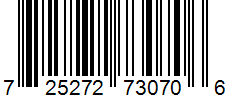Discover the GS1 Barcode System - Part 1: Learn the Basics
GS1 Barcode System Basics - Part 1
Hello to all readers! In this blog post, we'll dive into the fundamentals of the GS1 barcode system, unraveling the essential basics that make it a cornerstone in various industries.
Types of GS1 Barcodes
This post series provides a fundamental overview of the used barcode- and 2D code symbologies and explains terms like AI, data identifier, application identifier, or FNC1.
The GS1 system employs various barcode types to encode information, tailored to specific applications. These include EAN, UPC, GS1-128, GS1 DataBar, ITF-14, and the 2D codes GS1 DataMatrix and GS1 QR Code.
The choice of barcode type depends on the application area:
EAN and UPC Codes
 |
| EAN-13 Barcode |
 |
| UPC-A Barcode |
EAN codes are prevalent in Europe, while UPC codes are commonly found in North America. These codes, prominently used in retail product labeling, help streamline the checkout process at supermarkets. They contain a unique product identifier, the GTIN (Global Trade Identification Number). The codes are scanned by the Point of Sale (POS) system, such as the scanner system at a supermarket. Any additional data, such as item description or price, is retrieved from the market's database by the POS system using this GTIN.
The GTIN, assigned by the GS1 organization, ensures global uniqueness, preventing product collisions. If you need GTINs for retail product distribution, contact the GS1 organization in your country. See www.gs1.org for more information.
The focus of the remaining barcode types is on supply chain management and logistics applications:
ITF-14 Barcodes
 |
| ITF-14 Barcode |
GS1-128 Barcodes
 |
| GS1-128 Barcode |
GS1-128 symbols are basically Code 128 symbols with an additional encoded FNC1 character to comply with GS1 standards.
It's utilized for encoding variable product data, identifying logistical units, and is crucial in healthcare. The next post in this series explains how to create GS1-compliant GS1-128 symbols encoding multiple pieces of information.
GS1 DataBar
 |
| GS1 DataBar Barcode (Stacked Omni Variant) |
GS1 DataBar codes come in several variants and are usually readable with current POS systems. Certain GS1 DataBar codes allow the encryption of additional data such as weight, expiration date, or price. Think of weighed fresh products, for example.
GS1 DataMatrix
 |
| GS1 DataMatrix Code |
GS1 QR Code
 |
| GS1 QR Code |
The GS1 QR Code will become more important in the next few years, we will discuss this in a separate post.
The GS1 barcode system is a versatile tool that extends beyond retail, playing a crucial role in supply chain management, logistics, and even healthcare. In a future post, we'll delve into the intricacies of generating a correct GS1-128 code. Stay tuned for more insights into the world of GS1 barcodes!
GS1® is a registered trademark of the GS1 organization in various countries.
QR Code® is a registered trademark of DENSO WAVE INCORPORATED in the United States and other countries.



Comments
Post a Comment
No spam please, comments are moderated.
Thanks, TEC-IT